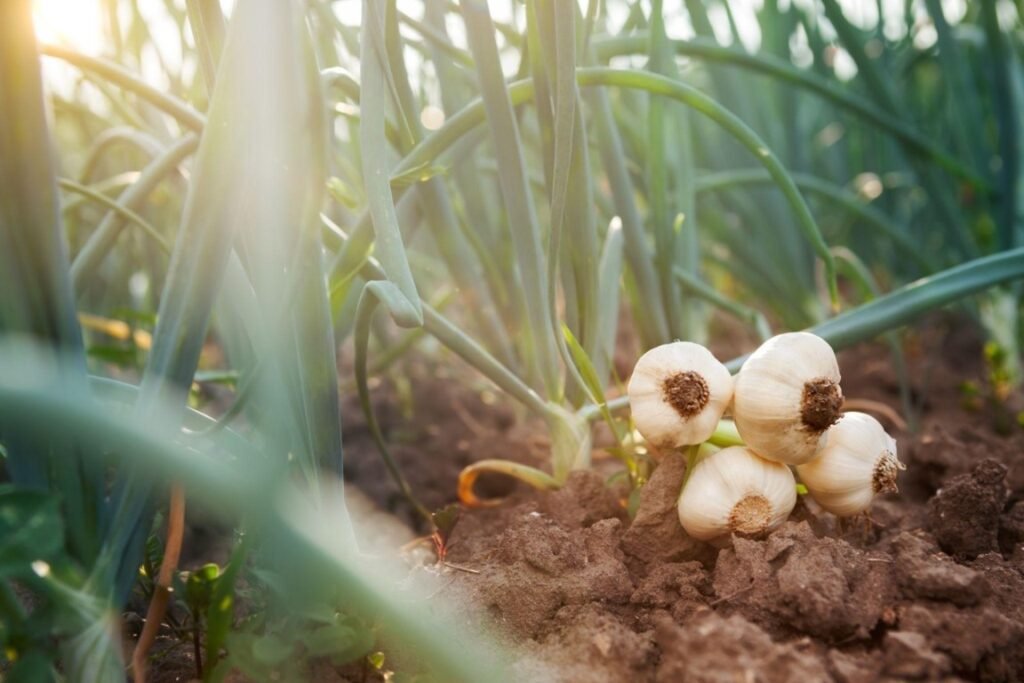
Watermelons – those juicy, sweet delights of summer, have a special place in many hearts. There’s nothing quite like sinking your teeth into a cool slice of homegrown watermelon on a scorching day. Not only are they a tasty treat, but they are also surprisingly easy to grow in your own backyard.
In this watermelon plant, growing and caring guide, we will explore what the plant looks like, how to plant watermelon seeds, when to plant them, and how to care for your watermelon plant throughout its growth. So, let’s begin:
What Does a Watermelon Plant Look Like?
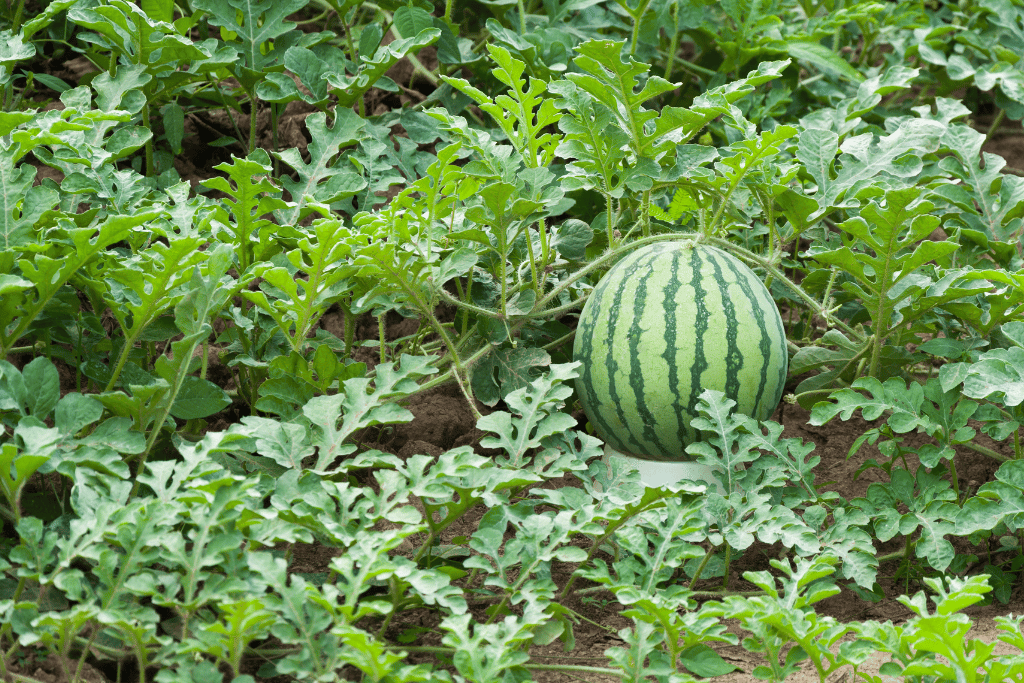
Before we dive into the details of the watermelon plant, growing and caring guide, it’s essential to understand what they look like. A watermelon plant consists of several distinctive parts:
Leaves: Watermelon plant leaves are large and lobed, similar in shape to those of a pumpkin or squash plant. They are typically deep green in color and have a rough texture. These leaves play a crucial role in photosynthesis, helping the plant produce energy from sunlight.
Vines: Watermelon plants are known for their long, trailing vines. These vines can sprawl across the ground or be trained to grow vertically if space is limited. They provide support to the developing fruit and help transport water and nutrients.
Flowers: Watermelon plants produce both male and female flowers. The male flowers have a slender stem, while the female flowers have a small, immature fruit at their base. Bees and other pollinators play a vital role in transferring pollen between these flowers, enabling fruit development.
Fruit: Of course, the most exciting part of a watermelon plant is the fruit itself. Watermelons come in various sizes and shapes, but they all have a thick rind, juicy flesh, and numerous seeds (or seedless, in some varieties). The fruit is typically green with distinctive dark green stripes.
When to Plant Watermelon Seeds

How Deep to Plant Watermelon Seeds: Watermelon seeds should be planted about 1 inch deep in the soil.
When to Plant Watermelon Seeds: The timing for planting watermelon seeds varies depending on your climate and local conditions.
- Cool Climates – In regions with cool climates and shorter growing seasons, it’s advisable to start watermelon seeds indoors about 2 to 3 weeks before your last frost date. Plan to transplant the seedlings into the garden approximately 2 weeks after the last frost date or when the soil has warmed to at least 65°F (18°C).
- Warmer Climates – In areas with warmer climates and longer growing seasons, you can directly sow watermelon seeds outdoors 1 to 2 weeks after your last frost date. However, ensure that the soil temperature has reached at least 65°F (18°C) before planting.
- Buying Young Plants – Another option, especially in cooler climates, is to purchase young watermelon plants from nurseries. Plant these tender plants once there is no longer a risk of frost. To expedite the warming of the soil, consider using black plastic mulch (Inorganic Mulch) to cover the planting area. Starting with young plants can result in an earlier harvest, typically up to 2 weeks earlier.
Readying a Suitable Planting Site – Here’s What You Need to Know
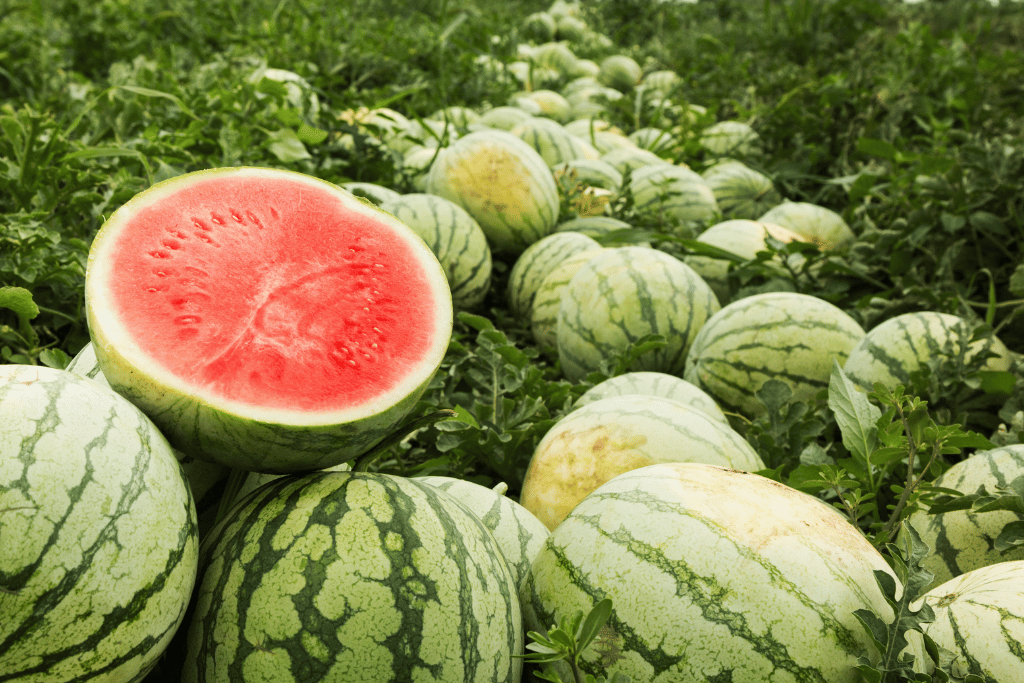
Amending the Soil:
Before planting watermelons, it’s essential to prepare the soil properly. Watermelons are considered heavy feeders, which means they require fertile soil with high nutrient levels. You can amend the soil by incorporating aged manure, seaweed, and compost. These organic materials enhance soil fertility and provide essential nutrients for plant growth.
Soil Type:
Watermelons thrive in loamy, somewhat-sandy, and well-drained soil. They may struggle in soil with excessive clay content that doesn’t drain well. Ensure your chosen planting site meets these soil criteria for optimal watermelon growth.
Soil pH:
Watermelons prefer soil with a pH level between 6.0 and 7.5, which falls within the range of slightly acidic to neutral. Soil within this pH range supports healthy plant development.
Spacing:
Watermelons demand ample space to grow. Each plant can require up to 20 square feet of area. This space is essential because watermelon vines need room to sprawl without crowding out other crops. To facilitate good drainage and heat retention, consider growing the vines in raised rows or hills. Plan to space the individual plants 2-3 feet apart within a 5-foot-wide hill. If you opt for traditional rows, ensure they are at least 6 feet apart to accommodate the spreading vines.
Best Time to Plant Watermelon
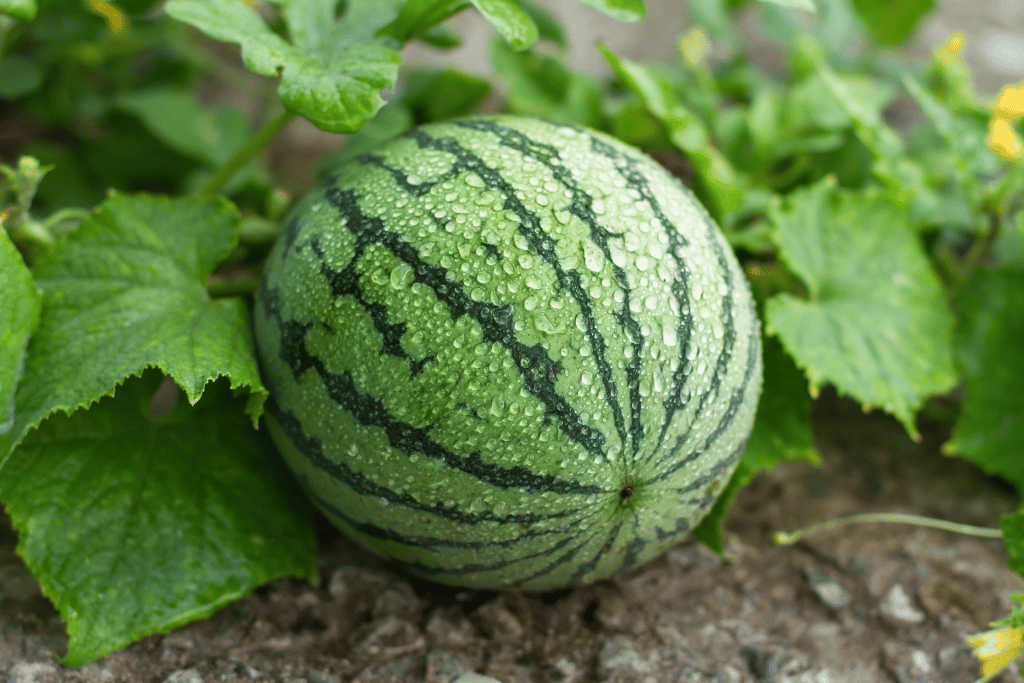
The best time to plant watermelon varies depending on your location. In general, aim for late spring to early summer when the soil is warm, and the risk of frost has passed. If you live in a colder climate, consider starting seeds indoors a few weeks before the last frost date and transplanting seedlings outdoors when it’s safe.
How to Plant Watermelon Seeds and Transplant Seedlings
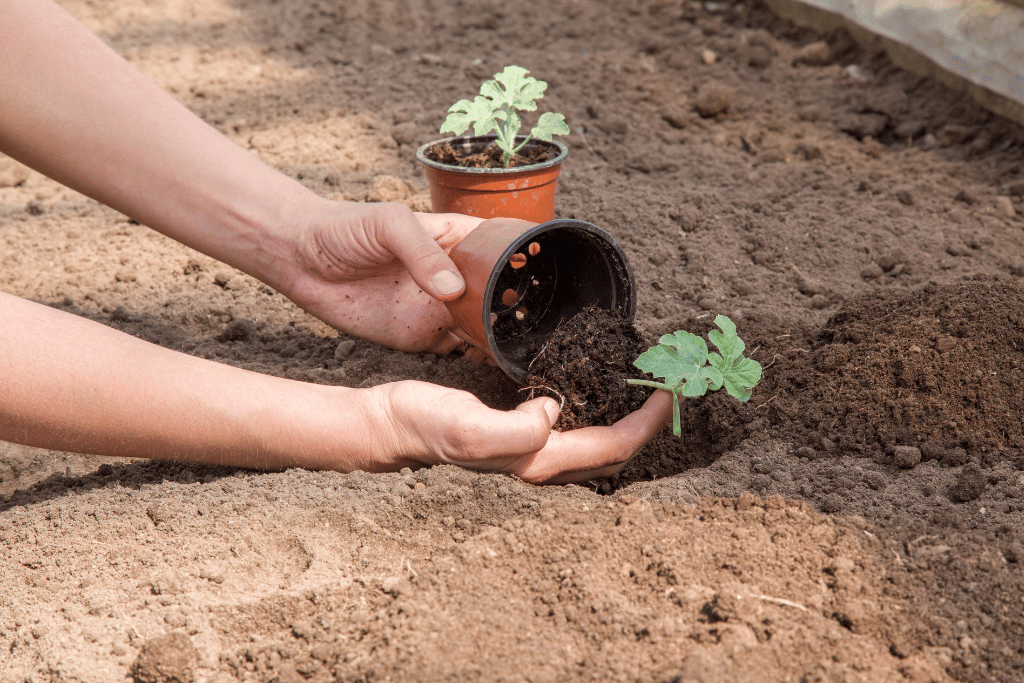
Now that we know what a watermelon plant looks like, let’s dive into the comprehensive process of planting watermelon seeds and learn the various watermelon growing stages, which also includes transplanting seedlings.
- Selecting Seeds: Start by choosing high-quality watermelon seeds from a reputable source. You can opt for traditional seeded varieties or seedless ones, depending on your preference.
- Soil Preparation: Watermelons thrive in well-drained, loamy soil. Ensure that your soil is rich in organic matter and has a slightly acidic to neutral pH level. You can amend the soil with compost or well-rotted manure to improve its fertility.
- Seed Spacing: Plant watermelon seeds about 1 inch deep in hills or rows. Hills should be spaced 3 to 4 feet apart, and each hill can accommodate several seeds. If planting in rows, space them 5 to 6 feet apart.
- Watering: Water the seeds thoroughly after planting to ensure good soil contact. Keep the soil consistently moist throughout the germination and early growth stages.
- Germination: Watermelon seeds typically germinate within 4 to 10 days when the soil temperature is within the range of 70-95°F (21-35°C). You can use a soil thermometer to monitor soil temperature accurately.
Transplanting Seedlings:
If you live in a region with a shorter growing season or want to get a head start on your watermelon crop, consider starting seeds indoors and then transplanting the seedlings into your garden. Here’s how to do it:
- Seed Starting: Begin by planting watermelon seeds in biodegradable seed pots or trays filled with a quality seed-starting mix. Plant the seeds about 1/2 inch deep. Keep the soil consistently moist and maintain a temperature of around 80°F (27°C) for optimal germination.
- Harden Off Seedlings: When seedlings have developed true leaves and are about 2-3 inches tall, begin the hardening-off process. Gradually expose them to outdoor conditions, starting with a few hours of sunlight and increasing the time each day. This helps acclimate the seedlings to the outdoor environment.
- Transplanting: Once the danger of frost has passed and your seedlings are hardened off, it’s time to transplant them into the garden. Choose a location with well-drained soil and sufficient sunlight. Space the seedlings according to the recommended guidelines, leaving 2-3 feet between plants or hills.
- Care for Transplants: After transplanting, water the seedlings well to reduce transplant shock. Provide consistent care, including regular watering and protection from pests and harsh weather conditions.
- Supporting Vines: As your watermelon vines grow, consider providing support if they are sprawling varieties. You can use trellises or garden netting to keep the vines off the ground, preventing damage to the developing fruit.
Watermelon Plant Spacing: Creating Adequate Room for Growth
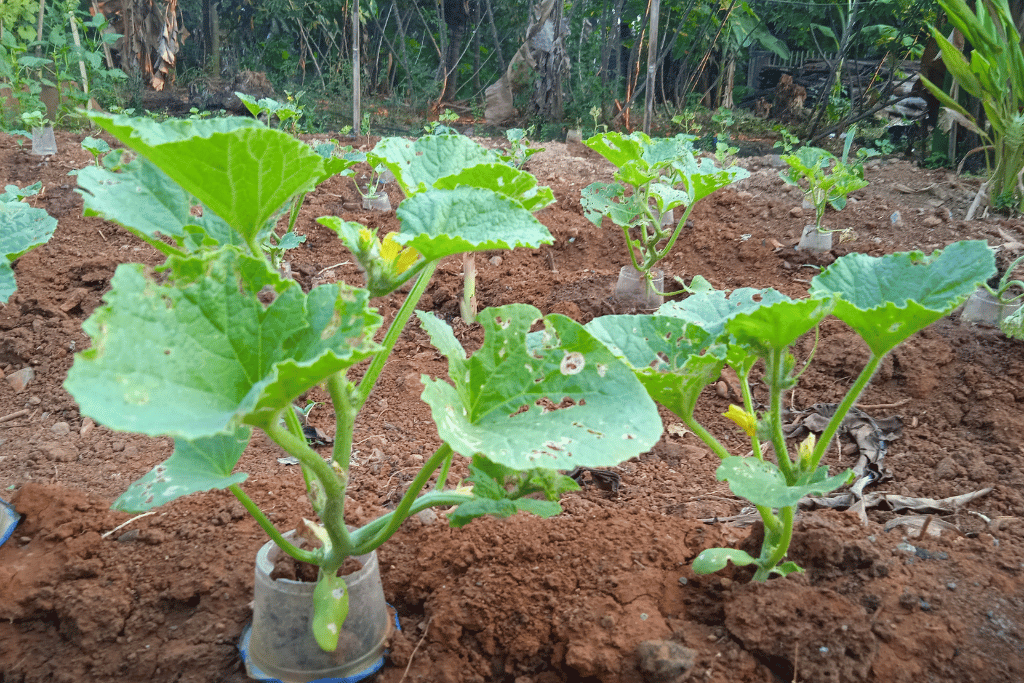
Proper watermelon plant spacing is essential for ensuring healthy growth, optimal fruit development, and efficient garden management. Watermelon plants have specific spacing requirements that should be followed diligently. Let’s explore the importance of spacing and the recommended guidelines for planting watermelon.
The Need for Ample Space
Watermelons are known for their vigorous vines and sprawling growth habit. To accommodate their exuberant nature, watermelon plants require a considerable amount of space. Here’s why giving them ample room is crucial:
- Preventing Crowding: Watermelons are space hogs. If they are planted too closely together or near other crops, they can quickly overshadow and crowd out neighboring plants. Adequate spacing ensures that each watermelon plant has sufficient access to sunlight, nutrients, and water.
- Air Circulation: Proper spacing promotes better air circulation between the plants. Good air circulation is essential for reducing the risk of fungal diseases, which can thrive in damp, crowded conditions.
- Efficient Management: When watermelon plants are appropriately spaced, it becomes more manageable to tend to the garden. Weeding, pruning, and harvesting are easier tasks when there is ample room to maneuver among the plants.
Growing in Hills for Ideal Spacing
One effective method for achieving proper watermelon plant spacing is to grow them in raised rows or hills. This approach offers several advantages:
- Improved Drainage: Raised rows or hills elevate the plants slightly above the surrounding soil, ensuring excellent drainage. Proper drainage is crucial for preventing waterlogged roots and related problems.
- Heat Retention: The raised rows or hills also have the added benefit of retaining heat. This helps warm the soil more quickly in the spring and maintains adequate soil temperature for optimal watermelon growth.
Recommended Spacing Guidelines
To provide the necessary space for your watermelon plants, consider the following spacing guidelines:
- Hill Planting: When growing watermelons in hills, plan to space the plants 2 to 3 feet apart within a 5-foot-wide hill. This spacing allows each plant ample room to spread its vines and leaves without overcrowding.
- Traditional Rows: If you choose to plant watermelons in traditional rows, ensure that the rows are spaced at least 6 feet apart. This wide row spacing accommodates the sprawling vines and prevents them from encroaching on adjacent rows or plants
Watermelon Plant Care
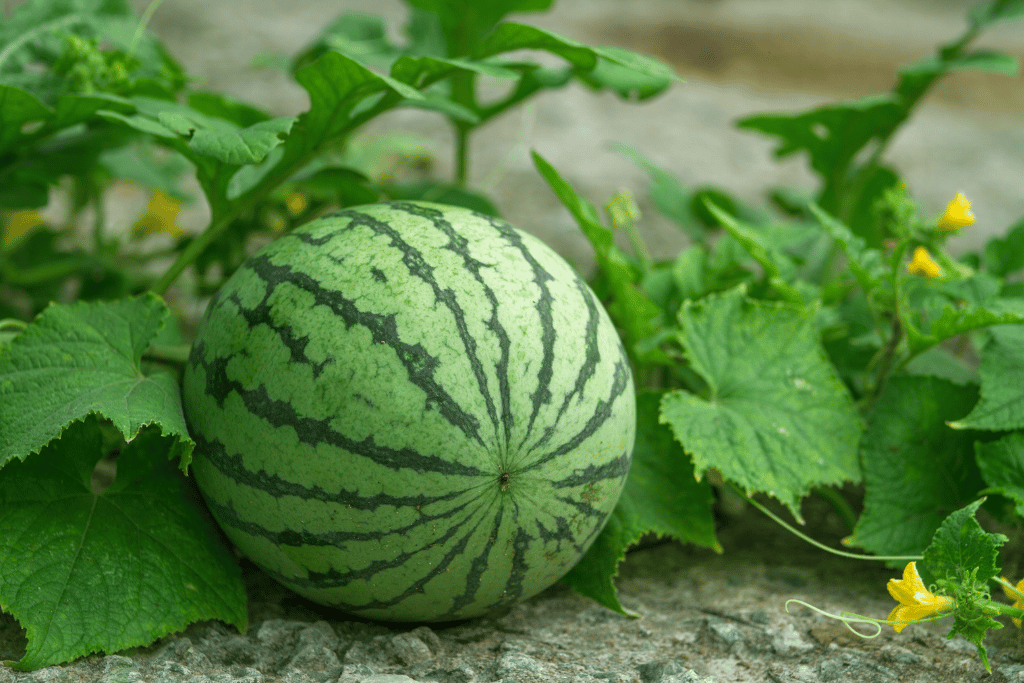
Caring for your watermelon plants is a vital aspect of ensuring a bountiful harvest of sweet, juicy fruit. Proper care includes attention to watering, fertilizing, understanding the flowering and fruiting process, and implementing general care practices to support healthy plant growth. Let’s explore these essential elements of watermelon plant care in detail.
Watering
Watering is critical for watermelon plants, especially during their growth, blooming, and fruit-setting stages. Here are some key considerations for effective watering:
- Consistent Moisture: From the time of planting until the formation of fruit, watermelon plants require a consistent supply of moisture. Ideally, they should receive about 1 to 2 inches of water per week.
- Soil Moisture: While it’s crucial to keep the soil moist, avoid waterlogging, which can lead to root rot and other problems. Water at the base of the vines in the morning to allow time for the foliage to dry before evening.
- Avoid Wetting Leaves: When watering, take care not to wet the leaves, as this can promote the development of fungal diseases. Overhead watering should be avoided whenever possible.
- Reduce Watering as Fruit Develops: Once the fruit begins to grow, you can gradually reduce the frequency and amount of watering. Dry weather conditions during fruit development can contribute to sweeter melons.
Fertilizing
Proper fertilization is essential for watermelon plants, and the type of fertilizer and its timing matter. Here’s what you need to know:
- Nitrogen-Rich Fertilizer: During the initial growth stages, opt for a fertilizer with a higher nitrogen content. Nitrogen encourages leaf and vine growth, which is essential for the development of a robust plant.
- Transition to Phosphorus and Potassium: As flowering begins, switch to a fertilizer with less nitrogen and a higher phosphorus and potassium content. This shift encourages the production of flowers and fruits rather than excessive foliage. A seaweed-based fertilizer can be an excellent choice.
Flowering and Fruiting
Comprehending the flowering and fruiting process of watermelon plants is crucial for successful cultivation:
- Male and Female Flowers: Watermelon vines produce male and female flowers separately on the same plant. Male flowers typically appear several weeks before female flowers. Don’t be alarmed if the male flowers fall off; it’s the female flowers that will bear fruit.
- Pollination: A successful fruit set depends on pollination. Bees are vital pollinators for watermelon plants, so create a pollinator-friendly garden to ensure proper pollination. Support these beneficial insects, and they will help your watermelon plants thrive.
- Prevent Rot: As the fruit ripens, take precautions to prevent rotting. Gently lift the developing watermelons and place cardboard or straw underneath them. This helps create a barrier between the fruit and the soil, reducing the risk of rot.
Light Requirements
Watermelon plants are sun-loving crops that thrive in abundant sunlight. Here’s what you need to know about providing the right amount of light for your watermelon plants:
- Full Sun: Watermelons require full sun, which means they need a minimum of 6 to 8 hours of direct sunlight each day. In fact, more sunlight is even better, as it promotes healthy vine growth and fruit development.
- Sun Exposure: Choose a planting site that receives ample sunlight throughout the day. Avoid areas with excessive shade, as watermelon plants will struggle to grow and produce fruit in such conditions.
- Sun Direction: In regions with hot climates, consider planting watermelon vines where they can receive morning sunlight and partial shade during the hottest part of the afternoon. This can help prevent overheating and sunburn on the fruit.
Temperature Requirements
Temperature is a critical factor in watermelon plant care. Meeting their temperature requirements ensures successful growth and fruit development:
- Warm Soil: Watermelon seeds germinate best when the soil temperature is between 70-95°F (21-35°C). Use a soil thermometer to monitor and ensure that the soil is adequately warm for planting.
- Frost-Free Period: Watermelons are highly sensitive to frost. Wait until all danger of frost has passed before planting or transplanting seedlings into your garden. In cooler climates, consider using row covers or protective structures to extend the growing season.
- Optimal Growing Temperatures: Watermelon plants thrive in temperatures between 75-85°F (24-29°C) during the day and 65-70°F (18-21°C) at night. Extreme temperatures, whether too hot or too cold, can stress the plants and affect fruit development.
Humidity
Humidity levels can impact watermelon plants, particularly during the flowering and fruiting stages. Here’s how to manage humidity for your watermelon plants:
- Flowering and Fruiting: High humidity can be beneficial during the flowering and fruiting period, as it helps with pollination and fruit set. However, if humidity levels are excessively high, it can increase the risk of fungal diseases. Adequate air circulation can help mitigate this issue.
- Leaf Wetness: Avoid wetting the leaves of watermelon plants during watering. Wet foliage can encourage the development of fungal diseases. Instead, water at the base of the vines in the morning, allowing time for the leaves to dry before evening.
- Ventilation: If you’re growing watermelon plants in a greenhouse or enclosed space, ensure proper ventilation to control humidity levels. Adequate airflow can prevent the buildup of moisture and reduce the risk of fungal issues.
General Care Tips
Here are some general care tips to keep your watermelon plants healthy and productive:
- Mulching: Consider mulching around your watermelon plants with black plastic or straw. Mulch serves multiple purposes, including warming the soil, suppressing weed growth, and keeping developing fruits off the ground, preventing soil contact and potential rot.
- Pruning: While watermelon plants typically do not require extensive pruning, you can improve vine productivity by preventing lateral (side) vines from growing and sticking to the main vine. When the plant is young, trim off the end buds before the side shoots become vines. You can also selectively pinch off some blossoms to direct energy toward fewer melons, although it can be challenging to eliminate a potential fruit.
Harvesting and Storing Watermelons: Timing and Techniques

Harvesting watermelons at the right moment is crucial to enjoy their sweet and juicy goodness to the fullest. Watermelons do not ripen further after they are picked, so knowing when and how to harvest them is essential. Here, we’ll explore the signs of ripeness and the proper techniques for harvesting and storing your watermelons.
Determining Ripeness
Watermelons typically ripen over a span of about two weeks, making it essential to keep a close eye on them as they approach maturity. Here are some reliable methods to determine if a watermelon is ripe and ready for harvest:
- Thump Test: Gently thump the watermelon with your knuckles. If it produces a hollow, deep sound, it’s a sign that the watermelon is ripe. A dull thud may indicate that it’s not quite ready.
- Top Color: Examine the color on the top of the watermelon. When the stripes become less pronounced, and there is little contrast between them, the watermelon is likely ripe.
- Bottom Color: Check the color on the bottom of the watermelon. An immature watermelon will have a white or pale green bottom, while a ripe one will display a cream- or yellow-colored bottom.
- Press Test: Gently press your thumb or fingers against the watermelon’s skin. If it yields slightly to pressure, it’s a sign that the fruit is ripe. However, this method should be used with caution, as excessive squeezing can damage the fruit’s quality.
- Tendril Inspection: Examine the tendril closest to the stem where the watermelon is attached. If the tendril is green, the watermelon is not yet ripe. A tendril that is half-dead indicates that the watermelon is nearly ripe or ripe. When the tendril is fully dead, the watermelon is ripe or possibly overripe. At this stage, it won’t ripen any further and should be harvested.
Harvesting Techniques
Once you’ve determined that a watermelon is ripe, it’s time to harvest it. Follow these steps for a successful harvest:
- Use a Sharp Knife: To avoid damaging the fruit, use a sharp knife or garden shears to cut the stem close to the watermelon. Leaving a short stem attached to the fruit is preferable, as it can help prevent rot.
- Handle with Care: Handle the watermelon gently during the harvesting process to prevent any bruising or damage.
- Harvesting Time: Watermelons are typically ready for harvest 70-90 days after planting, depending on the variety and growing conditions. Keep track of the days from planting to estimate the harvest window.
Storing Watermelons
After harvesting, it’s essential to store watermelons properly to maintain their freshness and flavor. Here are some tips for storing your harvested watermelons:
- Cool and Dry Location: Store watermelons in a cool, dry place, such as a basement or a well-ventilated pantry. Keep them away from direct sunlight, which can cause them to over ripen and lose flavor.
- Avoid Refrigeration: Whole watermelons do not need to be refrigerated unless you prefer to enjoy them chilled. Once you cut into a watermelon, refrigerate any unused portions in an airtight container.
- Optimal Temperature: The ideal storage temperature for whole watermelons is around 50-60°F (10-15°C). If you refrigerate a cut watermelon, store it at temperatures between 36-40°F (2-4°C).
Different Types of Watermelon Varieties: Choose the Perfect Fit for Your Garden
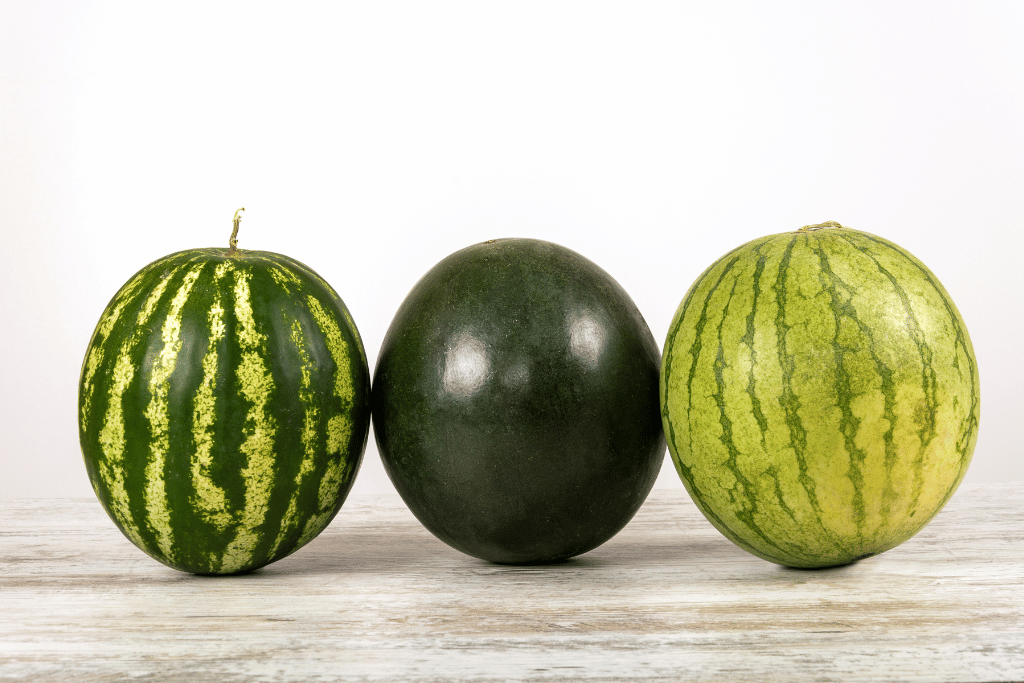
When it comes to selecting watermelon varieties for your garden, you have a diverse array of options to choose from, each with its unique characteristics. Your choice of watermelon variety should be based on factors such as available space, desired fruit size, seed preference, disease resistance, and the time you want to enjoy your harvest.
Standard Varieties
Standard watermelon varieties are known for producing large fruits on sprawling vines. These melons are typically seeded, and many have been bred for disease resistance against common issues like fusarium and anthracnose.
Here are some popular standard watermelon cultivars:
- ‘Charleston Grey’: Known for its gray-green rind and sweet, juicy flesh.
- ‘Crimson Sweet’: A favorite for its vibrant red flesh and high sugar content.
- ‘Jubilee’: Recognized for its classic appearance and deliciously sweet taste.
- ‘Sangria’: Known for its dark red, sweet flesh and resistance to diseases.
- ‘Moon & Stars’: Notable for its dark green rind with distinctive yellow “moon and stars” markings.
- ‘Royal Sweet’: Celebrated for its sweet flavor and disease resistance.
Icebox Varieties
Icebox watermelons are medium-sized fruits produced on shorter vines. These melons are perfect for smaller gardens and still offer exceptional flavor. Most icebox varieties yield melons weighing between eight to ten pounds. Here are some beloved icebox watermelon varieties:
- ‘Sugar Baby’: A classic choice known for its sweet, juicy flesh.
- ‘Sweet Beauty’: Renowned for its exceptional sweetness and compact size.
- ‘Mickeylee’: A favorite among gardeners for its delicious, petite melons.
- ‘Yellow Doll’: Unique for its yellow flesh and sweet taste.
Seedless Varieties
Seedless watermelons, as the name suggests, do not contain the typical brown or black seeds found in standard varieties. While they may have small, soft, and tasteless seed structures, they are generally seedless and easy to enjoy. It’s important to note that seedless varieties are hybrids, so saving seeds for the next season is not an option.
Some recommended seedless varieties include:
- ‘Supersweet’: Known for its excellent sweetness and juicy flesh.
- ‘Genesis’: Celebrated for its seedless nature and delightful taste.
- ‘King of Hearts’: A favorite for its heart-shaped appearance and sweet flavor.
- ‘Majestic’: Recognized for its deep red flesh and exceptional sweetness.
- ‘Cotton Candy’: Unique for its cotton candy-like flavor and texture.
Bush Varieties
Bush watermelon varieties are ideal for gardeners with limited space, as they produce medium-sized fruits on compact, bushy vines. These smaller plants typically yield fewer fruits per plant, making them suitable for container gardening.
Consider these bush watermelon varieties:
- ‘Bush Charleston Gray’: Known for its space-saving growth habit and classic flavor.
- ‘Bush Jubilee’: A compact option with the convenience of growing in small spaces.
- ‘Cal Sweet Bush’: A bush variety that produces sweet and juicy watermelons.
Early Varieties
If you’re eager to enjoy your watermelon harvest sooner rather than later, consider early-ripening varieties. These watermelons, often icebox types, produce medium-sized fruits that mature quickly. Here are some early watermelon varieties:
- ‘Bush Sugar Baby’: A bush variety of the classic ‘Sugar Baby’ known for its speed to maturity.
- ‘Golden Crown’: Early ripening with a sweet, golden flesh.
- ‘Yellow Baby’: A unique early variety with yellow flesh and a sweet taste.
- ‘Early Crimson Treat’: Delivers a quick harvest of deliciously sweet watermelons.
When selecting watermelon varieties, consider your gardening space, preferences, and local growing conditions. With the right choice, you can look forward to a bountiful and delicious watermelon harvest that suits your specific needs and tastes.
What to Plant With Watermelon: Companion Planting for Success

Companion planting is a gardening strategy that involves growing different plants near each other to create mutually beneficial relationships. When considering what to plant with watermelon, you can harness the power of companion plants to enhance the health and productivity of your watermelon crop. Let’s explore some ideal companion plants that can thrive alongside watermelons.
1. Corn (Zea mays):
Planting corn alongside watermelons can be a winning combination. Corn provides natural support for climbing watermelon vines, allowing them to grow vertically and maximize space utilization. In return, the sprawling watermelon vines can help shade the soil around the corn, reducing moisture loss and weed competition.
2. Radishes (Raphanus sativus):
Radishes make excellent companions for watermelons. These fast-growing root vegetables can help deter cucumber beetles, which can be harmful to watermelon plants. Planting radishes around your watermelons can act as a natural repellent, reducing the risk of beetle damage.
3. Nasturtiums (Tropaeolum majus):
Nasturtiums are not only beautiful but also beneficial companion plants for watermelons. They serve as trap plants, attracting aphids away from your watermelon plants. Aphids are notorious for damaging crops, so having nasturtiums nearby can help protect your watermelon crop.
4. Marigolds (Tagetes spp.):
Marigolds are renowned for their ability to repel various garden pests with their pungent scent. Planting marigolds near your watermelon patch can help deter common pests like nematodes and whiteflies. They create a natural barrier that keeps these pests at bay, reducing the need for chemical interventions.
5. Sunflowers (Helianthus spp.):
Sunflowers not only add beauty to your garden but also provide practical benefits as companion plants for watermelons. Their towering presence can offer partial shade to watermelon plants during the hottest part of the day, helping to prevent sunburn on the fruit. Additionally, sunflowers attract beneficial pollinators like bees, which can improve watermelon pollination.
6. Beans (Phaseolus spp.):
Planting bush beans near your watermelon patch can be mutually beneficial. Beans are nitrogen-fixing plants, which means they can enrich the soil by converting atmospheric nitrogen into a form that other plants can use. This can provide a nitrogen boost to your watermelon plants, promoting healthy growth.
7. Cucumbers (Cucumis sativus):
Cucumbers share similar growing conditions and requirements with watermelons. Planting them together can help maximize space and create a lush, productive garden. Just ensure that you provide adequate room for both plants to sprawl and avoid overcrowding.
Incorporating these companion plants alongside your watermelon crop can create a more diverse and balanced garden ecosystem. Companion planting not only helps deter pests but also enhances pollination and nutrient cycling, ultimately contributing to the overall health and productivity of your watermelon plants. Experiment with different combinations to find the mix that works best for your garden, and enjoy a thriving and fruitful harvest.
Watermelon Plant Troubleshooting: Addressing Common Problems
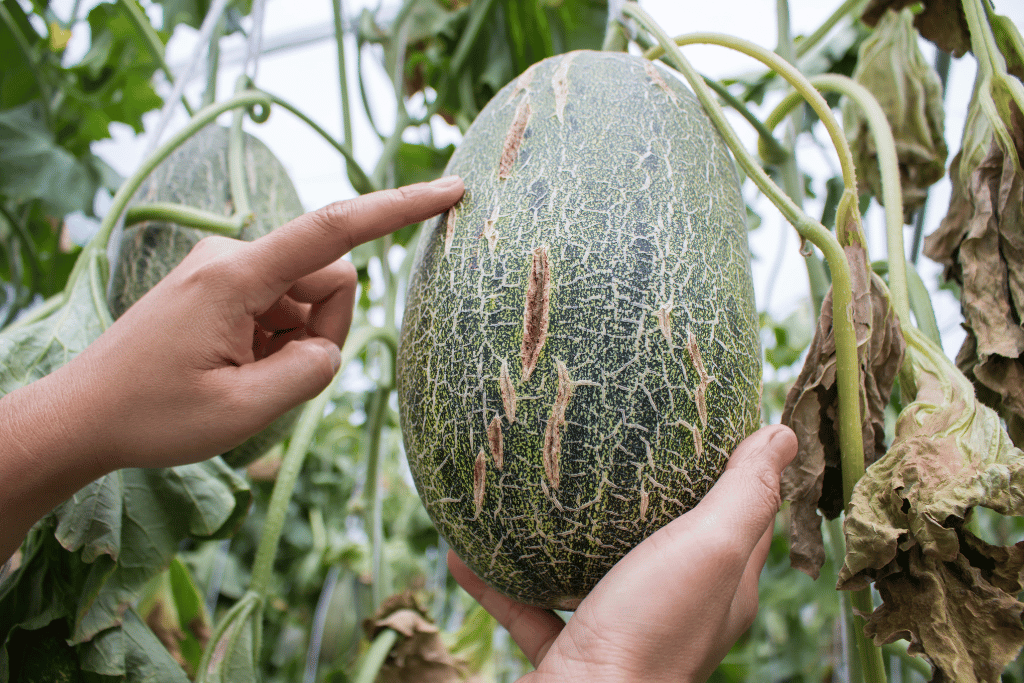
While cultivating watermelons can be a rewarding experience, gardeners may encounter common issues that can affect plant health and fruit production. It’s essential to be vigilant and proactive when it comes to troubleshooting these problems to ensure a successful harvest. Here, we’ll explore some of the most common issues watermelon growers face and how to address them effectively.
Wilting or Yellowing Leaves
Problem: Wilting or yellowing leaves in watermelon plants can be caused by various factors, including water stress, nutrient deficiencies, or pests.
Solution:
- Water Management: Ensure that your watermelon plants receive consistent and adequate moisture. Water deeply and regularly to prevent drought stress, especially during hot weather.
- Check Soil Drainage: Ensure proper soil drainage to prevent waterlogged roots, which can lead to wilting. Amending heavy clay soils with organic matter can improve drainage.
- Fertilize Appropriately: Yellowing leaves may indicate nutrient deficiencies. Provide balanced fertilizer according to your soil’s needs, and consider a foliar spray of micronutrients if deficiencies persist.
- Inspect for Pests: Some pests, like root-knot nematodes, can damage the roots, leading to wilting. Check the roots for signs of pest infestations and treat as necessary.
Pest Infestations
Problem: Watermelon plants can fall victim to various pests, including aphids, cucumber beetles, and spider mites, which can damage leaves and fruit.
Solution:
- Early Detection: Regularly inspect your watermelon plants for signs of pests, such as chewed leaves, discolored spots, or visible insects. Early detection allows for prompt intervention.Natural Predators: Encourage beneficial insects like ladybugs, lacewings, and parasitic wasps, which can help control pest populations.
- Neem Oil: Use neem oil or insecticidal soap to treat minor infestations of soft-bodied pests like aphids. Follow label instructions carefully.
- Physical Barriers: Employ row covers or netting to protect young seedlings from pests like cucumber beetles.
Disease Outbreaks
Problem: Watermelon plants are susceptible to various diseases, including powdery mildew, downy mildew, and fusarium wilt, which can weaken or kill the plants.
Solution:
- Plant Disease-Resistant Varieties: Choose watermelon varieties that are resistant to common diseases in your area.
- Crop Rotation: Practice crop rotation to reduce the risk of soil-borne diseases. Avoid planting watermelons in the same spot for consecutive years.
- Spacing and Airflow: Adequate spacing between plants promotes air circulation, reducing the conditions favorable for fungal diseases like powdery mildew.
- Fungicides: Apply appropriate fungicides according to the specific disease affecting your watermelon plants. Consult with your local extension service for guidance.
- Healthy Soil: Maintain healthy soil with proper pH levels and well-balanced nutrients to boost the plants’ disease resistance.
Poor Fruit Development
Problem: Poor fruit development in watermelons can result from inadequate pollination, inconsistent watering, or nutrient imbalances.
Solution:
- Hand-Pollination: If pollinators are scarce, consider hand-pollinating watermelon flowers. Gently transfer pollen from male to female flowers using a small brush or cotton swab.
- Consistent Watering: Ensure consistent moisture levels during flowering and fruit development. Inconsistent watering can lead to misshapen or underdeveloped fruit.
- Nutrient Management: Maintain proper soil fertility with balanced nutrients. A lack of essential nutrients can hinder fruit development.
- Thinning Fruit: If watermelon plants produce an excess of fruit, thin them to allow the remaining fruits to grow larger. Remove smaller or misshapen fruits.
Identifying and addressing these common problems promptly, you can enhance the health and productivity of your watermelon plants. Healthy plants are more likely to produce a bountiful harvest of sweet, juicy watermelons, making your gardening efforts all the more satisfying.
Final Words
I hope this comprehensive watermelon plant, growing and caring guide, provides invaluable insights into cultivating this beloved fruit. Now all you need to do is select the right variety, plant seeds and nurture your watermelon plants throughout their growth cycle until they’re ready for harvest.
FAQS
Can You Plant Watermelon and Cantaloupe Together?
Yes, you can plant watermelon and cantaloupe together in your garden. Both watermelon (Citrullus lanatus) and cantaloupe (Cucumis melo) are part of the cucurbit family, which includes various melon species, squash, and cucumbers. They share similar growing requirements and can coexist harmoniously in the same garden.
Keep in mind that watermelon and cantaloupe are capable of cross-pollination, which may affect the flavor and characteristics of the fruit. To minimize cross-pollination, you can plant them at a considerable distance from each other or use physical barriers like row covers.
How long do watermelons take to grow?
Watermelons typically take about 80 to 100 days from planting to maturity, depending on the variety and growing conditions. Shorter maturity varieties may be ready in as little as 70 days, while larger varieties can take up to 120 days.
What is DAP, and is it good for watermelons?
DAP stands for Diammonium Phosphate, which is a commonly used fertilizer. It contains nitrogen and phosphorus, both of which are essential for plant growth. While DAP can be used for watermelons, it’s important to use it in moderation and according to soil test recommendations. Excessive use of DAP can lead to imbalances in nutrient levels. It’s often recommended to choose a balanced fertilizer with a proper N-P-K ratio for optimal watermelon growth.
How to increase the fruit size of watermelons?
Polysulphate fertilizer can indeed help improve the fruit size of watermelons, as it provides a balanced mix of essential nutrients, including sulfur, potassium, and magnesium. To use polysulphate fertilizer for watermelons, follow these steps:
● Maintain consistent moisture levels throughout the growing season.
● Monitor the plants for signs of nutrient deficiencies or pests and address them promptly.
● Avoid over-fertilization, as excessive nutrients can lead to problems.
● Apply polysulphate fertilizer to the soil before planting, following the manufacturer’s instructions for the recommended application rate.
● Make sure the soil pH is within the optimal range for watermelons, which is typically around 6.0 to 6.8.
How many melons does one plant produce?
The number of watermelons produced by a single plant can vary depending on factors like the variety, growing conditions, and how well the plant is cared for. On average, you can expect a healthy watermelon plant to produce 2 to 4 melons per vine. However, some varieties may produce more, while others may produce fewer. Proper pruning, fertilization, and pest control can help maximize fruit production per plant.



